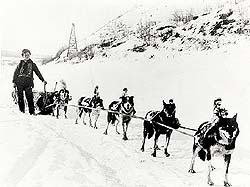 |
 
 |
 |
DOG-TEAMS
A dog-team usually consisted of
four to six dogs pulling one sleigh, sled or toboggan. "Four made a good team, there is a loss of power in proportion when over that number, but it is necessary to provide for casualties and for this reason five are better."27 Two men were required to work with every dog-team, one to go ahead of the dogs to make tracks with snowshoes, and the other one to follow behind to keep the sled in position.28
 |

Dog-Team, Yukon
© Public domain
National Library and National Archives
of Canada, C-064894
Five dogs were generally the recommended number for a team. Even if four dogs could handle the weight of the load, it was still preferable to have a fifth as backup in case of injury or accident. Sometimes the load was distributed among several sleds. |
 |

Arrival of the Royal and U.S. Mail,
Yukon, February 1907
Photo: William James Topley
© Public domain
National Library and National Archives
of Canada, PA-042585
There were usually five dogs to a team, however it was not unusual to find as many as eight to twelve dogs hitched to the same sled. |
By 1901, it took over 100 men, 50 teams and 150 dogs to fulfil the mail contracts, and meet the challenge of unexpected conditions and weather.29 "In the early fall and spring, when it was not safe to use horses, dogs and men were pressed into the service. Seventeen well equipped supply posts for the care of this force were maintained between Dawson and Whitehorse, and the expense incurred was enormous."30

|
 |